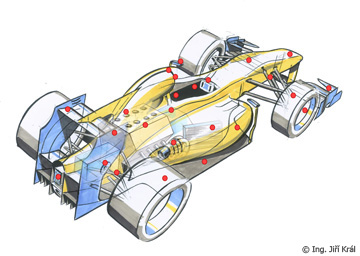High-quality weather services: UBIMET delivers technology and expertise to Formula 1
UBIMET | 20.8.14 | PoÄŤasĂ UBIMET F1
UBIMET Technology F1
It is not just the FIA and the racing teams that have plenty of work to do during Formula 1 Grand Prix. Austrian company UBIMET, an industry leader in weather forecasting and severe weather warnings, also has its own team and about 1,000 kg (2,200 lbs) of equipment on site at all Grand Prix. Over the course of its six-day Grand Prix deployments, UBIMET analyses about 7,200 radar images and - during the race sessions - processes more than 1,400 pages of data to produce weather forecasts in real time. This provides racing teams with weather forecasts and data that are updated on a minute-by-minute basis - information that is crucial in making decisions on car setup and strategy.

Vienna,
19th August 2014 - Formula 1 is eleven races into the season, with
eight Grand Prix yet to come. After a short summer break,
the Formula 1 season resumes with the Belgian Grand Prix on 24th August.
It is not just the racing teams and the FIA that are very busy in the
run-up to the race: the meteorologists and engineers of
UBIMET, an independent global provider of high-quality weather forecasts
and severe weather warnings, have been delivering weather services for
Grand Prix since the beginning of the 2014 season.
Weather forecasts: crucial to car setup and strategy
Weather
conditions have an impact not just on vehicle handling, but also on car
setup and team strategy. For Formula 1 Grand Prix weekends,
forecasts for the entire week are made available as early as Wednesday,
with updates being provided on a constant basis. Depending on weather
conditions, data and forecasts are updated every few
minutes during Formula 1 races. To accomplish this, 93 different kinds
of weather data are processed each minute.
In-house weather models and a new approach to measurement
To
provide an exceptional level of accuracy, UBIMET delivers all of its
forecasts by combining specially developed models and algorithms with
forecasts manually produced by experienced meteorologists. This
synthesis of sophisticated technology and meteorological expertise
enables the company to ensure highly accurate forecasts. Model
calculations are done on a minute-by-minute basis to issue forecasts
with high accuracy and in real time. Another important innovation is
that racing circuits are divided into three different
segments. Using this approach, UBIMET can deliver separate data and
forecasts for each segment of the circuit. This can be of great
importance: while one segment of the circuit is dry, other parts of
the track may still (or again) be wet.
Dr.
Michael Fassnauer, CEO of UBIMET GmbH, says: "Research and development
plays a central role at UBIMET. We are constantly improving and
enhancing our models and methods in order to tailor them to the
requirements in various fields such as Formula 1. Our in-house models,
the division of circuits into segments and the combination of
computer-generated and manually created forecasts allow us to set new
standards and to provide extremely detailed information. Weather is,
after all, a crucial factor in a large range of Formula 1 decisions - and these choices have to be made within very short periods
of time."
The onTRACK live weather information system
Racing
teams have two alternative options to access weather forecasts and
data. They can use either the FIA's internal information system or
onTRACK, the UBIMET-developed live weather information system that runs
on all common terminal devices. This provides easy access from any
location to information on factors including track
temperature, atmospheric pressure, wind and sunlight conditions, as well
as probability of precipitation.
About 1,000 kg of equipment, 7,200 radar images and 800,000 pieces of measurement data per race
The
UBIMET team follows the FIA and Formula 1 to every Grand Prix in order
to provide racing teams with weather forecasts. About 1,000 kg
(2,200 lbs) of equipment also have to be moved to each venue. That
includes weather stations, radar, radio modems, antennae and several
servers for on-site computations. Using these servers, the
company processes as much as 25 GB of weather data - equivalent to the
storage capacity of 36 CDs - and 1,440 radar images each and every day,
from Tuesdays before the Grand Prix until after the race
on Sunday. Since the start of this year's Formula 1 season, UBIMET has
processed 1,391 hours of measurement data, carried out 13,475
calculations and produced 336 forecasts.
Steffen
Dietz, meteorologist at UBIMET GmbH, says: "There is very close
co-operation between engineers and meteorologists in each and every
Grand Prix. We have tight schedules as we set up and test our equipment
on our own. Moreover, understanding regional weather patterns is
critical if meteorologists are to deliver accurate weather
forecasts. Our work therefore depends crucially on combining technology
and expert knowledge."
About UBIMET UBIMET is a global leading provider of weather services, forecasting systems and
tailor-made services. Delivering high-quality services and
meeting customer needs are UBIMET's top priorities.High-performance
computer systems and specialists from the fields of meteorology,
mathematics, physics, geosciences, biology and computer
science process and evaluate weather models, radar and satellite images
around the clock and throughout the year. This allows UBIMET to deliver
leading-edge solutions that help companies be more
efficient, successful and cost-aware than the competitors in their
industries. www.ubimet.com / www.uwz.at / www.wetter.tv
Photos:
Photo 1 / caption Producing forecasts involves not just mental work ©UBIMET
Photo 2 / caption Michael Fassnauer, CEO of UBIMET GmbH ©UBIMET MirjaGeh




